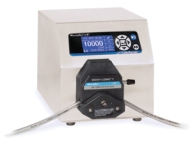Masterflex & More: Tech Experts Answer your Top Questions
Our tech experts respond to some of your most-asked questions, covering Masterflex® peristaltic pumps, pH, baths & circulators, and mixers.
 Masterflex Peristaltic Pumps and Tubing
Masterflex Peristaltic Pumps and Tubing
Q: I need a pump to pull up fluid from a reservoir. The pump will be several feet higher than the liquid. What pumps are good for this?
A: The term that rates a pump's ability to pull up fluid is called suction lift. You will need to find a pump that has a suction lift, usually rated in feet of H20, which is greater than the distance you need to pump. For example if you wanted to pump a fluid from a well that is 12', then you would need a pump that has a suction lift of at least 12 feet.
One pump technology that is excellent for suction lift is a peristaltic or tubing pump. Double air-operated diaphragm pumps are also great for this type of application, but are air powered. With either pump, you should always add some extra ability in the pump. If the fluid being pumped is more viscous, denser, or has a lower vapor pressure than water, the ratings also will need to be raised.
pH
Q: I need a pH electrode to measure many things in my lab including TRIS buffers. Which one should I go with?
A: TRIS buffers can contaminate or clog some probes, so choosing the correct electrode is important for these applications. In the past a specialized Calomel electrode was used. However, the internal reference pin in the electrode was made with Hg+, and due to mercury restrictions, these electrodes are no longer preferred. Instead any double junction electrode can be used. Single junction electrodes will be susceptible to clogging. The double junction has two layers of protection, which will ensure a decent life span of your probe even when measuring TRIS buffers.
Baths & Circulators
Q: I want to use a bath for a circulation loop application. Will my pump work?
A: To figure this out, we need to know: 1) How much heating or cooling energy your loop will need and 2) How much back pressure your system will be required to overcome
Both of these points are important. For 1) Equations can be used to approximate the amount of energy you need to maintain or heat your process and an error factor is applied to ensure that your unit has the ability. For 2) Most circulators include one or two pumps for circulation. If the unit only has the force pump, it may not be powerful enough. This pump is designed to maintain temperature uniformity, but may have some ability to circulate in open systems. An additional pump called a suction pump may be required, as it will provide considerable more pressure capabilities. Not all force/suction pumps are the same so care should be taken to ensure that the pressure output of the circulator.
Mixers
Q: My mixer isn't performing well, do you have a larger propeller?
A: We offer a wide selection of impellers, but let's make sure you need one. How is your mixer set up? What type of container do you have? Many poor mixing issues can be solved by adjusting the angle and placement of the mixer. The best angle varies from tank to tank but is usually around 15-20º offset. Straight up and down can cause vortexing, which is good for dispersion in light fluids but not as good for other mixing applications. A cylinder tank also is not ideal for mixing, but is most commonly used. If a square or rectangular container is available it may provide the mixing you are looking for.
Also, we need to be careful how much strain you put on your mixer. The motor on your mixer is only rated for so much torque. If chosen improperly, a small increase in diameter of your impeller can add an exponential load and wear out your motor.

Comentarios
Publicar un comentario